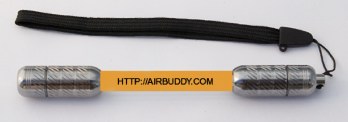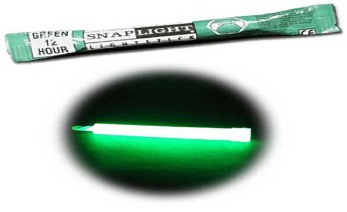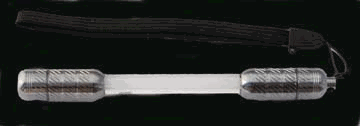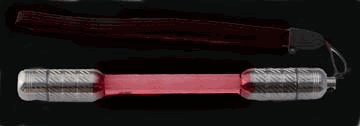Double Light Stick

The first lightstick was the chemical lightstick (shown below).
It was a boon to divers because it was a quick way to set up an underwater beacon or signal.
But it had many problems.

Once you turned it on you couldn't turn it off. You had to burn the entire stick and then throw it away. If you only needed the light for 5 or 10 minutes you had to burn the entire light anyway.
The cheap stick turned out to expensive.
Because it operated by breaking a small glass vial inside a soft plastic shaft, it was fragile and could be set off by accident if the shipping case was dropped or bumped. Since each stick was sealed in an opaque wrapper, there was no way to know if this had happened. Sometimes a diver, needing a beacon, took his chemical lightstick out of his
pocket, pealed off the wrapper, bent the stick to start it and found that the stick was already used up.
The cheap stick was untrustworthy.
So the battery operated, LED lightstick was invented.
This turned out to be a huge improvement over the chemical light.
You could turn it on and off, so it was inexpensive to use. The divers loved them.
But the LED lightsticks would frequently flood.
If you can get your hands on one, open up the battery compartment or switch area and look inside. You will find a simple threaded pipe with a single O-ring.
At Sea Turtle Scuba, we specialize in offering only products that offer great benefits over anything else on the market.
LED lightsticks are a great safety device for divers so we designed one that be twice as good as the others.
Take a look at the NEW Sea Turtle Double Lightstick

It looks similar to many of the other lightsticks on the market but it offers you exceptional features. Everything about it is double. Above and below you see the same light stick.

It has two built in light sources, one at each end, with separate switches and batteries.
You can choose from any of the following combinations.
- Flashing Green and Flashing Amber
- Flashing Green and Flashing White
- Flashing Red and Flashing White
- Flashing Amber and Flashing White
- Flashing Green and Constant White
- Flashing Red and Constant White
- Flashing Amber and Constant White
Choice of two flashing colors on indivudually or both on at the same time:
You can choose which color you will be using and switch from one color to another while you are under water. You can have either light mode on, both on, or both off.
As a beacon they give you a flexibility that you never had before unless you carried more than one lightstick.
You can use the two different colors to signify different messages to your dive buddy or class.
Or, if you need to use it as a beacon to attract help in an emergency, you can turn on the second set of batteries and light after the first set expires, giving you twice the burn time of any similar single signal light (up to 100 hours of burn time). That could save your life.
The constant white light will also function as a small light to see your gauges or watch or camera settings or even read your book in bed at night without disturbing your bunkie.
Use it on a string to drop down into your tank for a handy VIP inspection light.
You might want to put it on a small line and lower it down a hole in the reef with the constant white on to see what is down there, or place it on a surface to give you a bright spot to focus your camera.
Double means safety sealing as well.
If you look inside you will find that it is sealed on both ends with double O-rings, just like
all the best underwater electronic gear is made. It is not going to leak. Don't settle for a lightstick that has only a single O-ring seal to keep the water out. One grain of sand on that O-ring could mean a loss of light and a useless signal.
The bulbs will last 100,000 hours.
A set of 3 common LR44 / A76 watch type button batteries for each light will last up to 50 hours. It comes with 6 batteries.
Guaranteed leakproof to any depth you take it.
The Airbuddy Double Lightstick is twice as good as any other lightstick on the market.
It comes with your choice of TWO lights, six batteries and a wrist strap.
Use it for marking your entry/exit point, anchor, identify divemaster and team leaders, signal messages, attach to valuable pieces of equipment to make them easier to find, hang it from your boat, or waive it at the helicopter at night. Use it to lead your group of students or rally them to their individual assistant instructors on a night dive.
The signal ideas are as limitless as your imagination.
back to home page